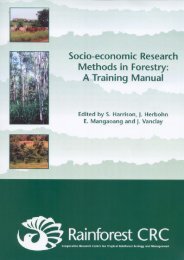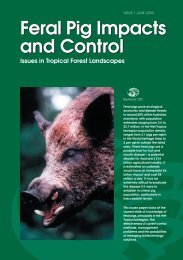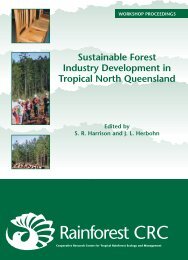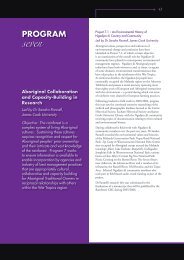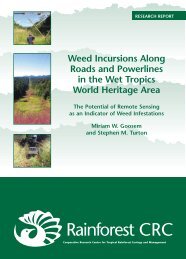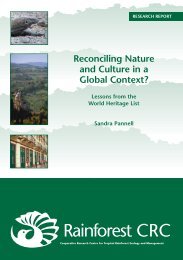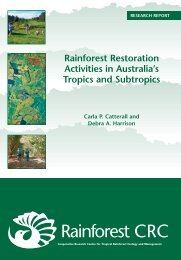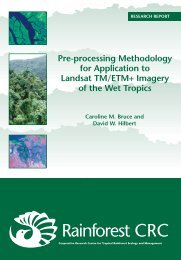Reconciling Nature and Culture in a Global Context? - Rainforest ...
Reconciling Nature and Culture in a Global Context? - Rainforest ...
Reconciling Nature and Culture in a Global Context? - Rainforest ...
You also want an ePaper? Increase the reach of your titles
YUMPU automatically turns print PDFs into web optimized ePapers that Google loves.
CHAPTER ONE – INTRODUCTION<strong>Reconcil<strong>in</strong>g</strong> <strong>Nature</strong> <strong>and</strong> <strong>Culture</strong> <strong>in</strong> a <strong>Global</strong> <strong>Context</strong>?Lessons from the World Heritage ListOur cultural <strong>and</strong> natural heritage are both irreplaceable sources of life <strong>and</strong><strong>in</strong>spiration. They are our touchstones, our po<strong>in</strong>ts of reference, our identity –UNESCO World Heritage CentreFor the past twenty years <strong>in</strong> Far North Queensl<strong>and</strong>, Aborig<strong>in</strong>al Traditional Owners haveargued for the acknowledgement of their cultural values <strong>in</strong> the Wet Tropics World HeritageArea. This two decade-long push for recognition ranges from greater <strong>in</strong>volvement <strong>in</strong> the dayto-daymanagement of the region, to a call for the renom<strong>in</strong>ation of the World Heritage-listedra<strong>in</strong>forests as a “liv<strong>in</strong>g cultural l<strong>and</strong>scape” (Wet Tropics Management Authority 2005: 1).This struggle has been framed by, <strong>and</strong> couched <strong>in</strong> terms of, a discourse on nature <strong>and</strong>culture. Try<strong>in</strong>g to underst<strong>and</strong> the terms of this discourse, the nature of people’s engagementwith it, <strong>and</strong> some of the un<strong>in</strong>tentional effects of it, forms a core element of this comparativestudy of World Heritage 1 . As I argue <strong>in</strong> this research report, the discursive currency of thisdebate reflects the dom<strong>in</strong>ant <strong>in</strong>terpretive paradigm of the World Heritage Convention.As the title suggests, the 1972 United Nations Educational, Scientific <strong>and</strong> CulturalOrganisation’s (UNESCO) Convention Concern<strong>in</strong>g the Protection of the World Cultural <strong>and</strong>Natural Heritage enshr<strong>in</strong>es one of the most pervasive dualisms <strong>in</strong> Western thought – that ofnature <strong>and</strong> culture (MacCormack <strong>and</strong> Strathern 1980). As Bloch <strong>and</strong> Bloch observe, we cantrace the nature-culture idea back to the Enlightenment period when the “notion of anopposition between nature <strong>and</strong> the state of society […] suddenly ga<strong>in</strong>s a great prom<strong>in</strong>ence”(1980: 27) 2 . From the 1700s onwards, nature <strong>and</strong> culture have acquired a range of shift<strong>in</strong>gmean<strong>in</strong>gs <strong>in</strong> both Western philosophical traditions <strong>and</strong> <strong>in</strong> common usage. For example, theconcept of nature has, among other th<strong>in</strong>gs, variously referred to a pre-social state, the<strong>in</strong>ternal processes of the human body, the universal order, <strong>in</strong>clud<strong>in</strong>g the “external world ofplants, animals <strong>and</strong> the countryside”, <strong>and</strong> “the way of life of primitive peoples” (Bloch <strong>and</strong>Bloch 1980: 27). Similarly, our ideas about culture are not static, notwithst<strong>and</strong><strong>in</strong>g the effortsof anthropologists <strong>in</strong> the course of the past hundred years to once <strong>and</strong> for all fix the mean<strong>in</strong>gof this ‘keyword’ (Williams 1976). As Kroeber <strong>and</strong> Kluckhohn observe <strong>in</strong> their ‘critical reviewof concepts <strong>and</strong> def<strong>in</strong>itions’, by the early 1950s, 164 anthropological def<strong>in</strong>itions of ‘culture’existed <strong>in</strong> the literature (Kroeber <strong>and</strong> Kluckhohn 1952). UNESCO’s World HeritageConvention provides yet another set of criteria for the def<strong>in</strong>ition of culture <strong>and</strong> ourunderst<strong>and</strong><strong>in</strong>g of nature.‘Cultural’ <strong>and</strong> ‘natural heritage’ are def<strong>in</strong>ed <strong>in</strong> Articles 1 <strong>and</strong> 2 of the Convention. Insummary, ‘monuments’, ‘groups of build<strong>in</strong>gs’ <strong>and</strong> ‘sites’, the latter be<strong>in</strong>g the “works of man orthe comb<strong>in</strong>ed works of nature <strong>and</strong> of man” (UNESCO 2005a: 13), are considered as ‘culturalheritage’. ‘Natural heritage’, on the other h<strong>and</strong>, refers to ‘physical <strong>and</strong> biological formations’,1 In the course of three months’ research between October 2005 <strong>and</strong> January 2006, I visited eighteenWorld Heritage properties, <strong>in</strong>clud<strong>in</strong>g Komodo National Park (listed <strong>in</strong> 1991), the Historic Centre ofMacau (2005), the Historic Centre of Rome (1980), Val d’Orcia (2004), the Historic Centre of the Cityof Pienza (1996), the Historic Centre of Sienna (1995), the Historic Centre of San Gimignano (1990),the Fortress of Suomenl<strong>in</strong>na (1991), the Rock Draw<strong>in</strong>gs of Alta (1985), Maritime Greenwich (1997),the Tower of London (1988), Westm<strong>in</strong>ster Palace, Westm<strong>in</strong>ster Abbey <strong>and</strong> Sa<strong>in</strong>t Margaret’s Church(1987), the Royal Botanic Gardens, Kew (2003), Stonehenge, Avebury <strong>and</strong> Associated Sites (1986),the City of Bath (1987), Paris, Banks of the Se<strong>in</strong>e (1991), the Statue of Liberty (1984) <strong>and</strong> the HawaiiVolcanoes National Park (1987).2 However, as Marshal Sahl<strong>in</strong>s po<strong>in</strong>ts out, Enlightenment ideas about nature <strong>and</strong> culture can be tracedback to Ancient Greece <strong>and</strong> the sophist’s opposition of custom (nomos) <strong>and</strong> nature (physis) (2004:16). Classical Greek ideas about nature <strong>and</strong> culture “were revived <strong>in</strong> Western Europe dur<strong>in</strong>g theseventeenth century” (ibid: 3).1




